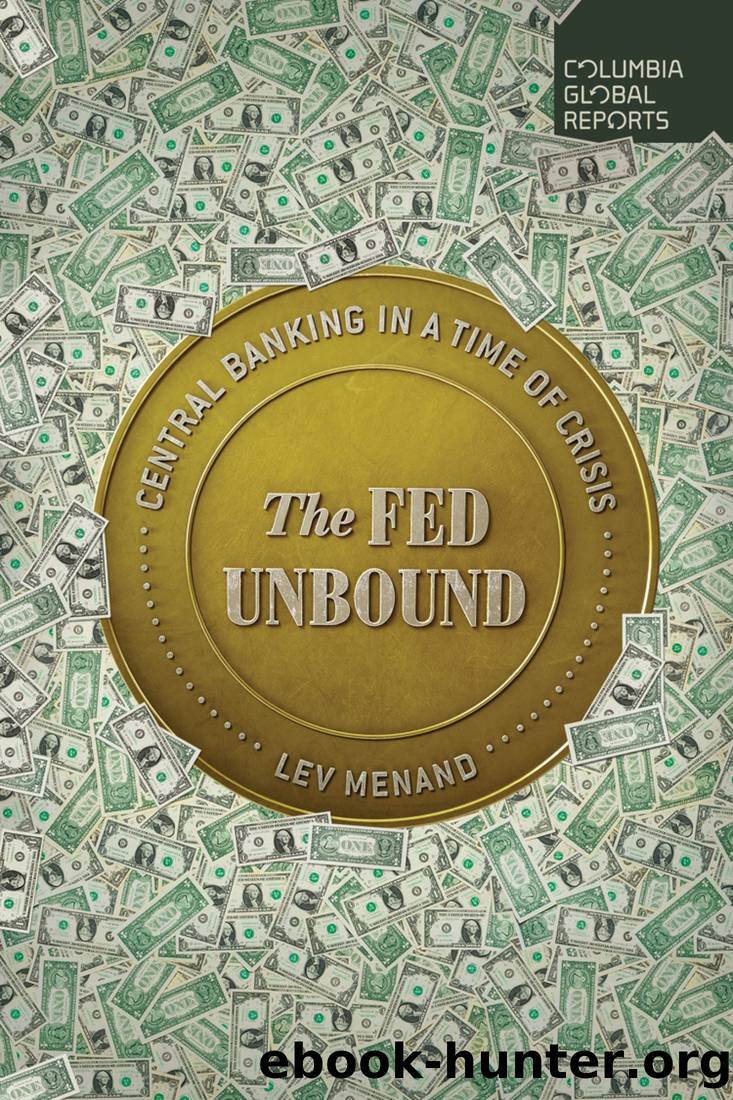The Fed Unbound: The Trouble With Government by Central Bank by Lev Menand

Author:Lev Menand [Menand, Lev]
Language: eng
Format: epub
Tags: Business & Economics, Banks & Banking, Money & Monetary Policy, Government & Business
ISBN: 9781735913704
Google: 29uwzgEACAAJ
Publisher: ColumbiaUP
Published: 2022-09-15T20:37:00+00:00
Nonbank Lending
There is another Fed lending tool, one that has received significant attention in recent years and that has the potential to operate much more like a bailout. This power, which allows the Fed to work around banks rather than through them, is codified in Section 13(3) of the Federal Reserve Act. It provides that, in âunusual and exigent circumstances,â the Fedâs Board can authorize the Federal Reserve Banks to lend to âany participant in any program or facility with broad-based eligibility,â even if the borrowers are not banks and do not have reserve accounts.
On the surface, this power seems to allow the Fed to act as a national bank rather than a monetary authority: extending credit as banks do and interacting directly with businesses, rather than regulating the supply of bank money as a monetary authority that oversees banks. But there are a variety of restrictions on this power that make it more like the Discount Window than many people assume. First, it is hard to activate. Unlike the Fedâs other tools, it requires the approval of the Secretary of the Treasury and a five-vote supermajority of the Fedâs Board. Second, it is designed to permit the Fed to step into the shoes of privately owned banks only when those banks are unable to do their job. Thus, before lending, 13(3) requires the Federal Reserve Banks to obtain evidence that borrowers are unable to access adequate credit accommodations from other banks (the âcredit availability provisoâ). Third, it requires the Fedâs Board to establish policies and procedures to ensure that (1) the Federal Reserve Banks secure their loans in ways that are âsufficient to protect taxpayers from losses,â (2) all borrowers are solvent, (3) loans are not designed to remove assets from the balance sheet of any single company, and (4) lending is for the purpose of providing liquidity to the financial system (the âfinancial system liquidity clauseâ).
Two of these restrictionsâthe credit availability proviso and the financial system liquidity clauseâare particularly limiting and underline the powerâs monetary purpose. The credit availability proviso prevents the Federal Reserve Banks from lending to households, nonprofits, municipalities, and businesses, as banks do, unless it can first obtain evidence that the banking system has ceased to function properly. The proviso was part of a compromise in 1932 between legislators who sought to empower the Reconstruction Finance Corporation, an organization created by Congress to serve as a general-purpose government lender, and President Hoover, who opposed government banking.* By adding 13(3) to the Federal Reserve Act, policymakers expected the Fed to replace lost credit in communities where banks had failed or were in such weak condition that they could not continue to lend to their existing customers. In other words, Congress extended the Fedâs administrative role in the banking system to include the task of ensuring that customers of damaged banks can still access credit.
Congress added the other major restriction on 13(3), the financial system liquidity clause, in 2010. This clause scales back the circumstances in which
Download
This site does not store any files on its server. We only index and link to content provided by other sites. Please contact the content providers to delete copyright contents if any and email us, we'll remove relevant links or contents immediately.
Bad Blood by John Carreyrou(6583)
Rich Dad Poor Dad by Robert T. Kiyosaki(6514)
Principles: Life and Work by Ray Dalio(6296)
Playing to Win_ How Strategy Really Works by A.G. Lafley & Roger L. Martin(6084)
Management Strategies for the Cloud Revolution: How Cloud Computing Is Transforming Business and Why You Can't Afford to Be Left Behind by Charles Babcock(4546)
The Confidence Code by Katty Kay(4220)
Thinking in Bets by Annie Duke(4185)
American Kingpin by Nick Bilton(3820)
Delivering Happiness by Tony Hsieh(3396)
Project Animal Farm: An Accidental Journey into the Secret World of Farming and the Truth About Our Food by Sonia Faruqi(3189)
The Power of Habit by Charles Duhigg(3095)
The Tyranny of Metrics by Jerry Z. Muller(3029)
Brotopia by Emily Chang(3026)
Mastering Bitcoin: Programming the Open Blockchain by Andreas M. Antonopoulos(3011)
The Marketing Plan Handbook: Develop Big-Picture Marketing Plans for Pennies on the Dollar by Robert W. Bly(3007)
I Live in the Future & Here's How It Works by Nick Bilton(2960)
The Content Trap by Bharat Anand(2888)
Applied Empathy by Michael Ventura(2864)
Building a StoryBrand by Donald Miller(2863)
